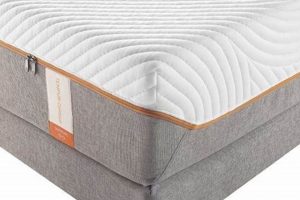The process of significantly reducing the volume of a viscoelastic polyurethane bed for relocation or storage involves a series of specific steps. This procedure aims to make the bulky item more manageable for transport or placement in confined spaces. Successful execution minimizes the risk of damage during handling.
Decreasing the size of such a mattress offers several advantages. It can dramatically lower shipping costs due to reduced dimensional weight. Further, it simplifies maneuvering the item through doorways, hallways, and stairwells, mitigating potential harm to both the mattress and the surrounding environment. Historically, individuals and companies have sought effective compression methods to optimize logistics and storage capacity.
The subsequent sections will detail the necessary materials, preparation techniques, and step-by-step instructions to ensure proper implementation of this compression procedure.
Key Considerations for Foam Bed Volume Reduction
Achieving optimal compression results requires careful planning and execution. The following tips offer guidance to minimize complications and ensure the structural integrity of the item during and after the process.
Tip 1: Prior to initiating any compression efforts, thoroughly clean the mattress surface. Removing dust, debris, and potential allergens minimizes the risk of embedding these particles within the foam during compression, which could negatively impact hygiene and longevity.
Tip 2: Invest in a high-quality mattress bag specifically designed for this purpose. The bag should be durable, airtight, and appropriately sized to accommodate the mattress. A substandard bag is prone to tearing, compromising the compression process and potentially exposing the mattress to environmental elements.
Tip 3: Employ a reliable vacuum device with sufficient suction power. A weak or inefficient vacuum will prolong the compression time and may fail to achieve the desired volume reduction. Test the vacuum on a small, contained area before committing to the entire mattress.
Tip 4: During the vacuuming process, distribute pressure evenly across the mattress surface. Avoid concentrating suction in a single area, as this can lead to uneven compression and potential damage to the foam structure. Work methodically, ensuring all sections are adequately vacuumed.
Tip 5: Secure the mattress bag tightly once the desired compression level is achieved. Use heavy-duty tape or straps to reinforce the seal and prevent air from re-entering the bag. A loose seal negates the effects of compression and renders the effort ineffective.
Tip 6: Monitor the mattress closely during and after compression for any signs of damage or deformation. If unusual creasing or tearing is observed, discontinue the process and consult with a professional. Ignoring these warning signs can result in irreversible damage to the mattress.
Tip 7: After decompression, allow the mattress ample time to fully expand and regain its original shape. This process may take several hours or even days, depending on the duration of compression and the material’s density. Avoid placing undue stress on the mattress during this recovery period.
Adhering to these guidelines maximizes the chances of successful volume reduction while preserving the integrity and usability of the viscoelastic polyurethane bed. These steps ensure a smoother, more efficient handling experience. The subsequent sections will explore practical applications for the compressed mattress and considerations for long-term storage.
1. Preparation
The initial phase of compacting a viscoelastic polyurethane mattress, termed “Preparation,” dictates the efficiency and outcome of the entire process. Comprehensive groundwork minimizes complications and maximizes the potential for successful volume reduction. Neglecting this stage can result in damage, hygiene issues, and ineffective compression.
- Cleaning the Mattress Surface
Thorough removal of dust, debris, and potential allergens from the mattress surface is crucial. Embedded particles during compression can compromise the mattress’s hygiene and longevity. A clean surface also allows for a tighter seal within the compression bag. Example: Using a vacuum cleaner with a HEPA filter followed by wiping with a damp cloth can effectively remove contaminants. Failing to clean properly can lead to mold growth and unpleasant odors post-compression.
- Selecting the Correct Compression Bag
Choosing a bag specifically designed for mattress compression is essential. It must be durable, airtight, and of appropriate size to fully encapsulate the mattress. A bag made of thin, non-durable material is prone to tearing, compromising the compression and exposing the mattress to environmental elements. Example: Bags constructed from heavy-duty polyethylene with reinforced seams are optimal. Using a garbage bag as a substitute will likely result in failure and potential damage to the mattress.
- Gathering Necessary Tools
Ensuring all required tools are readily available before commencing the compression process streamlines the operation and prevents delays. This includes a powerful vacuum cleaner, heavy-duty tape, straps, and protective gloves. Lacking these tools can lead to inefficient compression and potential physical strain. Example: A vacuum cleaner with a hose attachment and crevice tool is highly effective. Attempting to use a handheld vacuum may prove inadequate and time-consuming.
- Assessing Environmental Conditions
Performing the compression in a clean, dry, and well-ventilated area is important. Humidity can promote mold growth within the compressed mattress, and inadequate ventilation can hinder the vacuuming process. Example: A garage or large indoor space with open windows is preferable to a damp basement. Compressing a mattress in a humid environment significantly increases the risk of mold contamination.
These preparatory steps collectively establish the foundation for successful compacting. Addressing each facet with meticulous attention ensures a higher likelihood of achieving significant volume reduction while safeguarding the structural integrity and hygienic condition of the viscoelastic polyurethane mattress. The effectiveness of subsequent stages relies heavily on the thoroughness of this preliminary work.
2. Airtight Bag
The selection and utilization of a specialized, airtight bag is a critical determinant in the efficacy of compacting a viscoelastic polyurethane mattress. Its primary function is to provide a sealed environment, allowing for effective air extraction and maintained volume reduction. A compromised bag undermines the entire compacting process, rendering other effor
ts futile.
- Material Composition and Durability
The bag’s construction material must exhibit high tensile strength and puncture resistance to withstand the pressures exerted during vacuuming and subsequent handling. Polyethylene blends or reinforced polymers are common choices. A bag constructed from thin or easily damaged material will likely fail, leading to air leakage and loss of compression. For example, industrial-grade bags with a thickness of at least 6 mil are recommended. The use of standard garbage bags is generally inadequate due to their lack of durability and airtight sealing capabilities.
- Size and Fit Specificity
The dimensions of the bag must correspond accurately to the size of the mattress. An undersized bag will be impossible to seal completely, while an oversized bag introduces excess air volume, hindering the compression process. The bag should allow for a snug fit around the mattress, minimizing air pockets. For example, a queen-size mattress requires a bag specifically designed for that dimension. Employing a king-size bag for a twin mattress will result in inefficient air extraction and reduced compression effectiveness.
- Sealing Mechanism and Integrity
The bag must incorporate a reliable sealing mechanism to prevent air re-entry after vacuuming. This typically involves a heavy-duty zipper or a heat-sealable closure. The seal must be airtight and resistant to tearing or separation under pressure. For example, double-zippered bags with an overlapping flap provide enhanced sealing integrity. Relying on tape alone is often insufficient, as tape adhesives can fail over time, leading to air leakage and mattress re-expansion.
- Valve Design and Placement
The bag may include a one-way valve to facilitate air extraction while preventing backflow. The valve should be durable, easily accessible, and compatible with standard vacuum cleaner attachments. Its placement on the bag should allow for optimal air removal from all areas of the mattress. For example, valves positioned near the foot of the mattress are often more effective at removing air than those placed in the center. A poorly designed or malfunctioning valve can impede the vacuuming process and compromise the overall compression outcome.
In summary, the airtight bag is not merely a container; it is an integral component of the compacting process. Its material composition, size specificity, sealing mechanism, and valve design directly influence the degree of compression achieved and the longevity of the reduced volume state. The selection of a high-quality, purpose-built bag is therefore essential for successful and sustained mattress compacting. Neglecting this aspect can render all other efforts ineffective.
3. Vacuum Suction
Vacuum suction represents a critical force in achieving effective compaction of viscoelastic polyurethane mattresses. The application of negative pressure facilitates the removal of air trapped within the foam structure, enabling a significant reduction in volume. Without adequate vacuum suction, the mattress cannot be sufficiently compressed, negating the purpose of the procedure.
- Vacuum Power and Airflow Rate
The effectiveness of vacuum suction is directly proportional to the vacuum’s power and airflow rate, measured in units such as Air Watts or Cubic Feet per Minute (CFM). A higher power rating and CFM indicate a greater capacity to extract air quickly and efficiently. For instance, a vacuum designed for heavy-duty cleaning tasks will generally outperform a standard household vacuum in compacting a mattress. Insufficient vacuum power will result in prolonged extraction times and a less compressed final state. This necessitates using specialized equipment designed for large volume reduction.
- Nozzle Design and Surface Coverage
The design of the vacuum nozzle influences the distribution of suction force across the mattress surface. A wide, flat nozzle provides greater surface coverage, promoting even compression and preventing localized deformation. Nozzles with concentrated suction can create uneven pressure points, potentially damaging the foam structure. For example, a nozzle specifically designed for upholstery cleaning may be more suitable than a standard floor nozzle. Inadequate nozzle design leads to non-uniform compression and potential damage to the mattress.
- Seal Integrity and Air Leakage Prevention
Maintaining a tight seal between the vacuum nozzle and the mattress bag is essential for maximizing suction efficiency. Air leakage reduces the negative pressure applied to the mattress, diminishing the effectiveness of the vacuuming process. Techniques such as using tape or specialized airtight attachments can minimize air leaks. For example, ensuring the vacuum hose is securely connected to the bag’s valve is critical. Air leakage undermines the suction force, resulting in suboptimal mattress compression.
- Extraction Time and Compression Duration
The duration of vacuum suction directly impacts the degree of compression achieved. Prolonged extraction allows for continued air removal, leading to greater volume reduction. However, excessive compression can potentially damage the foam structure. The optimal extraction time depends on the mattress’s density and the vacuum’s power. For example, denser mattresses may require longer extraction times. Insufficient extraction results in incomplete compression, while excessive extraction risks material damage.
In summary, the application of vacuum suction is paramount for effectively compacting a viscoelastic polyurethane mattress. The power of the vacuum, the design of the nozzle, the integrity of the seal, and the duration of extraction all contribute to the success of the compression process. Optimizing these factors ensures maximum volume reduction while preserving the integrity of the mattress. The principles of vacuum suction underpin the entire operation.
4. Even Pressure
Maintaining uniform pressure distribution across the surface of a viscoelastic polyurethane mattress during compacting is critical to prevent structural damage and ensure consistent volume reduction. Uneven pressure can lead to localized deformation, potentially compromising the mattress’s integrity and long-term comfort. The following considerations outline the importance of this principle.
- Distribution of Weight During Manual Compression
When manually compressing a mattress to initiate air expulsion before vacuum sealing, evenly distributing body weight or applying pressure via flat, rigid surfaces is paramount. Concentrating force in a single area can create creases and compress the foam unevenly, leading to permanent indentations. For example, using wide boards to distribute pressure rather than focusing solely on knee pressure reduces the risk of damage. Non-uniform weight distribution results in irregular compression and potential foam degradation.
- Vacuum Nozzle Movement and Surface Coverage
During vacuuming, the nozzle should be moved systematically across the entire mattress surface, ensuring that suction is applied uniformly. Overlapping passes and consistent speed prevent areas from being over-compressed while others remain insufficiently compacted. An example involves us
ing a gridded approach, ensuring each section receives equal attention. Haphazard nozzle movement creates inconsistencies in compression and can lead to localized stress points. - Support Structures and Underlying Surfaces
The surface upon which the mattress rests during the compression process must be flat and supportive. Uneven surfaces can create pressure points, leading to deformation. Using a solid platform or spreading a protective layer like a thick blanket underneath the mattress helps distribute weight evenly. For example, compacting a mattress on a bed frame with protruding springs will likely result in uneven compression and potential damage to the springs. Improper support surfaces compromise the uniformity of compression.
- Straps and Binding Techniques
If straps or binding materials are used to further compress the mattress after vacuuming, they must be applied uniformly and with consistent tension. Unevenly tightened straps can create localized pressure points, leading to deformation. Regularly spaced straps with even tension distribution are recommended. For example, using ratchet straps with consistent tension settings ensures uniform compression across the mattress. Uneven strap tension can cause permanent creases and irregularities in the foam structure.
In conclusion, uniform pressure distribution is an indispensable element in successfully compacting a viscoelastic polyurethane mattress. Addressing weight distribution during manual compression, employing proper vacuum nozzle techniques, ensuring adequate support structures, and utilizing straps with even tension all contribute to a uniform and damage-free compression process. Neglecting these considerations can lead to irreversible damage and compromise the mattress’s long-term usability.
5. Secure Sealing
Achieving and maintaining a state of reduced volume in a viscoelastic polyurethane mattress hinges critically on the implementation of secure sealing techniques. The integrity of the seal dictates the longevity of the compressed state and prevents the influx of air that would negate the prior compression efforts. Therefore, secure sealing represents an indispensable step in any method designed for volume reduction.
- Closure Mechanism Integrity
The type of closure mechanism employed directly impacts the effectiveness of the seal. Zippers, heat seals, and adhesive tapes are common options, each with varying degrees of reliability. Zippers must be robust and tightly interlocking, while heat seals require consistent temperature and pressure for complete fusion. Adhesive tapes must possess strong bonding properties and resistance to temperature variations. For example, a double-zipper system with an overlapping flap offers enhanced protection against air leakage compared to a single zipper. The selection of an inadequate closure mechanism inevitably leads to seal failure and mattress re-expansion.
- Material Compatibility and Adhesion
The sealing material must exhibit compatibility with the material of the mattress bag to ensure proper adhesion and prevent delamination. Incompatibility can result in weak bonds and compromised seal integrity. For instance, using a solvent-based adhesive on a polyethylene bag can degrade the plastic and create pathways for air entry. Selecting appropriate materials based on their chemical properties is essential for a durable seal. A mismatch in material properties compromises the seal and its ability to maintain compression.
- Environmental Factors and Seal Performance
Environmental conditions such as temperature, humidity, and exposure to ultraviolet (UV) radiation can significantly affect the performance of the seal. High temperatures can weaken adhesives, while humidity can compromise the integrity of certain sealing materials. UV radiation can degrade plastics and reduce their sealing effectiveness. For example, storing a compressed mattress in a hot, humid environment accelerates seal degradation and re-expansion. Consideration of environmental factors is crucial for long-term storage solutions.
- Post-Sealing Inspection and Reinforcement
After sealing, a thorough inspection for any signs of air leakage is necessary. Applying additional layers of tape or reinforcing the closure with straps can further enhance seal security. Small leaks can gradually lead to mattress re-expansion over time. For instance, using a soapy water solution to check for air bubbles around the seal can identify potential weak spots. Reinforcing the seal provides an added layer of protection against air infiltration and ensures sustained compression.
The various facets of secure sealing underscore its significance in the overall process of compacting viscoelastic polyurethane mattresses. The selection of appropriate closure mechanisms, consideration of material compatibility, awareness of environmental factors, and implementation of post-sealing inspection protocols collectively contribute to the maintenance of a compressed state. Without a reliable and durable seal, the effort invested in mattress compacting is ultimately rendered futile.
6. Post-Compression
The actions taken subsequent to compacting a viscoelastic polyurethane mattress, referred to as “Post-Compression,” directly influence the long-term success and viability of the entire undertaking. The immediate steps following the compression phase can either preserve the reduced volume and material integrity or inadvertently compromise the preceding efforts. Therefore, understanding this connection is essential for individuals or entities involved in transporting, storing, or otherwise manipulating compressed mattresses.
One critical aspect of “Post-Compression” is proper storage. The compressed mattress should be placed in a clean, dry environment shielded from direct sunlight and extreme temperatures. Exposure to these elements can degrade the sealing material, leading to air leakage and subsequent re-expansion. For instance, storing a compressed mattress in an unheated storage unit during winter months could cause the adhesive on the sealing tape to fail, allowing air to seep in and negate the compression. Furthermore, the orientation of the stored mattress is important; placing heavy objects atop the compressed mattress can cause localized deformation, impacting its shape upon decompression. Therefore, a deliberate and controlled storage environment is crucial. Another factor involves the decompression process. Rushing the decompression or applying excessive force during the cutting of the compression bag can lead to tears in the mattress fabric or uneven expansion of the foam. The mattress should be allowed ample time to gradually regain its original shape, potentially requiring several days for complete restoration, depending on the duration of compression and the foam’s density.
In summary, “Post-Compression” activities form an integral and inseparable part of “how to compress memory foam mattress.” Neglecting these post-compression considerations jeopardizes the effectiveness of the initial compression effort, potentially resulting in material damage, seal failure, and incomplete volume reduction. Understanding and implementing appropriate “Post-Compression” procedures are vital for realizing the benefits of mattress compression, whether for logistical efficiencies or prolonged storage.
Frequently Asked Questions
The following addresses common inquiries regarding the process of reducing the volume of a viscoelastic polyurethane mattress for transport or storage. These answers aim to provide clarity and practical guidance.
Question 1: Can all viscoelastic polyurethane mattresses be compressed using these methods?
While many viscoelastic polyurethane mattresses are amenable to compression, certain models, particularly those incorporating innerspring systems or containing gel infusions, may present challenges. The presence of rigid components can impede uniform compression and potentially lead to damage. Consultation with the mattress manufacturer is advisable prior to attempting compression.
Question 2: How long can a viscoelastic polyurethane mattress remain in a compressed state without sustaining damage?
The duration for which a viscoelastic polyurethane mattress can remain compressed without experiencing detrimental effects varies depending on factors such as foam density, compression ratio, and storage conditions. Prolonged compression can lead to permanent deformation or reduced loft. It is generally recommended to limit the compression period to no more than three months to mitigate these risks.
Question 3: Is specialized equipment required to compress a viscoelastic polyurethane mattress effectively?
While manual compression methods are feasible, employing specialized equipment such as industrial-strength vacuum pumps and purpose-built compression bags can enhance efficiency and reduce the risk of damage. The use of professional-grade equipment is particularly beneficial for larger or denser mattresses.
Question 4: What are the potential risks associated with compressing a viscoelastic polyurethane mattress?
Improper compression techniques can result in structural damage, including tearing of the foam, deformation of the support layers, and compromise of the mattress’s overall integrity. Furthermore, inadequate cleaning prior to compression can lead to the growth of mold or mildew within the compressed mattress, posing a health hazard.
Question 5: How does compression affect the warranty of a viscoelastic polyurethane mattress?
The impact of compression on the mattress warranty varies depending on the manufacturer’s policies. Some warranties may be voided if the mattress is subjected to compression techniques, while others may remain valid provided that the compression is performed in accordance with specific guidelines. Review of the warranty terms and conditions is essential.
Question 6: What measures should be taken to facilitate the mattress’s recovery after decompression?
After decompression, the mattress should be placed on a flat, well-ventilated surface and allowed ample time to fully expand. This process may take several hours or even days, depending on the duration of compression and the ambient temperature. Avoid placing excessive weight or pressure on the mattress during this recovery period to ensure uniform expansion and prevent localized deformation.
Careful adherence to recommended procedures and a thorough understanding of the potential risks are essential for successfully compressing a viscoelastic polyurethane mattress. This mitigates damage and maintains structural integrity.
The subsequent sections will explore practical applications for the compressed mattress and considerations for long-term storage.
Compressing Viscoelastic Polyurethane Mattresses
This exploration of “how to compress memory foam mattress” detailed the critical steps involved in volume reduction for these items. Success hinges on methodical preparation, including thorough cleaning and appropriate bag selection. Proper vacuum suction, applied with even pressure distribution, forms the cornerstone of effective air extraction. Finally, a secure, airtight seal is vital to preserve the reduced volume. Post-compression handling and storage significantly impact the procedure’s long-term success.
The decision to undertake viscoelastic polyurethane mattress compression necessitates careful consideration of the potential benefits and risks. When executed with precision and adherence to best practices, this procedure offers logistical advantages and storage efficiencies. However, improper execution can compromise the mattress’s structural integrity and longevity. Prospective users should assess their individual needs and circumstances before proceeding.


![Best Memory Foam Camper Mattress [Deals!] Organic & Natural Mattress Buyer’s Guide: Non-Toxic Sleep Solutions Best Memory Foam Camper Mattress [Deals!] | Organic & Natural Mattress Buyer’s Guide: Non-Toxic Sleep Solutions](https://mattressworldpa.com/wp-content/uploads/2025/07/th-4035-300x200.jpg)

![Best Memory Foam Futon Mattress for Comfy Sleep [Guide] Organic & Natural Mattress Buyer’s Guide: Non-Toxic Sleep Solutions Best Memory Foam Futon Mattress for Comfy Sleep [Guide] | Organic & Natural Mattress Buyer’s Guide: Non-Toxic Sleep Solutions](https://mattressworldpa.com/wp-content/uploads/2025/07/th-4033-300x200.jpg)


